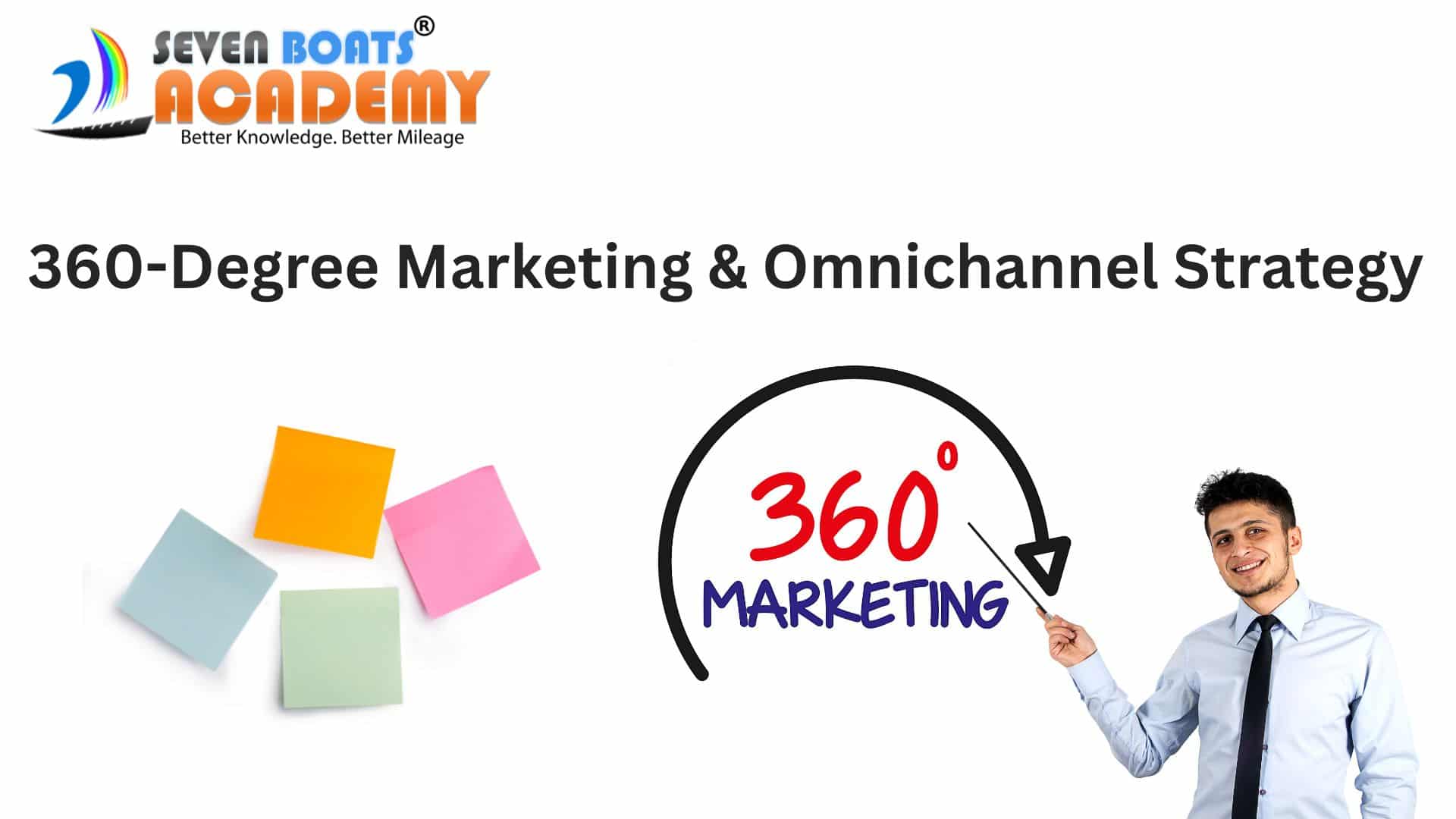
Master 360-degree marketing & omnichannel strategy with these MBA notes. Covers planning, benefits, digital marketing integration, and customer engagement.
Course: MBA Program
Module: Marketing Management / Digital Marketing / Marketing Communications
Topics: 360-Degree Marketing Definition, Omnichannel Strategies Benefits & Importance, Developing a 360 Marketing Plan, Aligning Brand Messaging, Digital Marketing Integration (SEO, PPC, Social Media, Content, Email), Customer Engagement Strategies.
Introduction:
Building on the principles of Integrated Marketing Communications (IMC), this module delves into the concepts of 360-degree marketing and omnichannel strategies. These approaches emphasize a holistic view of the customer and their journey, aiming to create seamless, consistent, and engaging experiences across all possible interaction points, both online and offline.
1. What is 360-Degree Marketing?
Definition:
360-degree marketing refers to a marketing strategy that aims to reach customers at all possible points of contact (touchpoints) in their daily lives and throughout their entire customer journey. It’s about creating a complete circle of communication around the customer, ensuring brand presence and consistent messaging wherever the customer might encounter the brand.
Core Concept: It adopts a holistic view, considering every available channel – digital (website, social media, email, search engines, mobile apps) and traditional (TV, radio, print, outdoor, events, point-of-sale) – as part of a unified campaign. The goal is to surround the target audience with the brand message in a cohesive way.
Relationship with IMC: 360-degree marketing is essentially an application and extension of IMC principles. While IMC focuses on coordinating the message across channels, 360-degree marketing emphasizes reaching the customer through all relevant channels with that coordinated message.
Key Characteristics:
- Holistic View: Considers the entire marketing landscape and customer journey.
- Customer-Centric: Focuses on where the customer is and how they interact with media and the brand.
- Multi-Channel Approach: Utilizes a wide range of online and offline channels.
- Consistent Messaging: Ensures brand voice, values, and offers are aligned everywhere.
- Data-Driven: Relies on understanding customer behaviour across different touchpoints.
(Potential Exam Question: Define 360-degree marketing and explain how it relates to the principles of Integrated Marketing Communications (IMC).)
2. Benefits & Importance of Omnichannel Strategies
What is Omnichannel Marketing?
Omnichannel marketing focuses on creating a seamless and integrated customer experience across multiple channels, allowing customers to move fluidly between them without disruption or loss of context. Unlike multi-channel (where channels exist but may operate in silos), omnichannel integrates these channels so they work together harmoniously from the customer’s perspective.
Example: A customer browses a product on a mobile app, adds it to their cart, later accesses the cart on a desktop website to complete the purchase, and opts for in-store pickup, receiving SMS notifications about their order status – all as part of one smooth experience.
Benefits & Importance:
- Enhanced Customer Experience: Provides convenience, consistency, and personalization, leading to higher customer satisfaction. Customers don’t have to repeat information or restart processes when switching channels.
- Increased Customer Loyalty & Retention: A seamless experience fosters trust and makes customers feel valued, encouraging repeat business.
- Improved Brand Image: Consistent messaging and experience across channels reinforce brand identity and professionalism.
- Higher Engagement Rates: Customers can interact with the brand on their preferred channel at their convenience, leading to deeper engagement.
- Better Data Collection & Insights: Tracking customer interactions across integrated channels provides a richer, unified view of customer behaviour, preferences, and pain points.
- Increased Sales & Revenue: By reducing friction in the buying process and improving loyalty, omnichannel strategies often lead to higher conversion rates and increased customer lifetime value (CLV).
- Competitive Advantage: In an era of high customer expectations, providing a superior omnichannel experience can be a key differentiator.
(Potential Exam Question: Differentiate between multi-channel and omnichannel marketing. Discuss the key benefits of implementing an omnichannel strategy for a business.)
3. Developing a Comprehensive 360 Marketing Plan
A 360 marketing plan integrates various channels and tactics around a central theme or objective. The development process mirrors the IMC planning framework:
- Understand Your Audience & Their Journey (Foundation):
- Deeply research target audience demographics, psychographics, media consumption habits, online behaviour, and pain points.
- Map the customer journey, identifying all potential touchpoints (online and offline) where the audience might interact with the brand or seek information.
- Set Clear Objectives:
- Define SMART goals for the campaign (e.g., increase website traffic from social media by 15%, generate 500 qualified leads via content marketing, improve brand sentiment score by 10 points). Objectives should align with overall business goals.
- Develop a Unified Core Message & Creative Theme:
- Craft a central message that resonates with the target audience and reflects the brand’s value proposition. Develop a consistent creative look and feel (visuals, tone of voice) to be used across all materials.
- Select Channels & Tactics (The 360 Mix):
- Choose a mix of relevant online and offline channels based on objectives, target audience behaviour, and budget. Consider how channels can complement each other (e.g., TV ad drives search traffic, social media promotes event attendance).
- Examples: SEO, PPC, social media marketing, content marketing, email, affiliate marketing, influencer marketing, PR, print ads, TV/radio, events, direct mail, in-store promotions.
- Allocate Budget:
- Distribute the budget across chosen channels and tactics based on expected reach, impact, and ROI. Use methods like objective-and-task.
- Create Content & Assets:
- Develop specific content formats (blog posts, videos, ad copy, social media updates, brochures, email newsletters) tailored for each channel, while maintaining message consistency.
- Establish Metrics & Measurement Plan:
- Define Key Performance Indicators (KPIs) for each channel and the overall campaign. Set up tracking mechanisms (e.g., UTM parameters, analytics platforms, CRM integration) to monitor performance across the customer journey.
- Execute & Coordinate:
- Launch the campaign across all channels in a coordinated manner. Ensure internal teams and external agencies are aligned.
- Monitor, Analyze & Optimize:
- Continuously track performance against KPIs. Analyze data to understand what’s working and what’s not. Optimize channel mix, messaging, and tactics based on insights.
(Potential Exam Question: Outline the key steps involved in developing a comprehensive 360-degree marketing plan.)
4. Aligning Brand Messaging Across All Platforms
Consistency is the cornerstone of IMC, 360-degree marketing, and omnichannel strategies.
Why is Alignment Crucial?
- Builds Trust & Credibility: Consistent messages reinforce brand identity and make the brand seem reliable.
- Reduces Customer Confusion: Contradictory messages can confuse customers and dilute brand perception.
- Strengthens Brand Recall: Repeated exposure to a consistent message and visual identity improves memorability.
- Creates Synergy: Reinforces the core message, making the overall communication effort more impactful than the sum of its parts.
How to Achieve Alignment:
- Develop Clear Brand Guidelines: Create comprehensive guidelines covering brand voice, tone, personality, visual identity (logo usage, color palette, typography), and core value proposition. Ensure these are accessible to everyone involved in communications (internal teams, agencies).
- Define a Core Campaign Message: Establish the single most important idea or theme for any specific campaign that should be reflected everywhere.
- Centralized Strategy & Planning: Use the IMC/360 planning process to ensure all activities stem from a common strategy and objectives.
- Cross-Functional Collaboration: Encourage regular communication and collaboration between different marketing teams (digital, PR, traditional advertising, sales) and even other departments (customer service, product development). Break down organizational silos.
- Shared Content Calendars & Assets: Use shared tools to plan content and ensure assets are consistent and readily available.
- Agency Briefings & Coordination: Provide clear, consistent briefs to all external agencies and facilitate regular coordination meetings.
- Training: Train employees (especially customer-facing ones) on brand messaging and values.
- Regular Audits: Periodically review communications across all platforms to check for consistency and identify any deviations.
(Potential Exam Question: Explain why aligning brand messaging across all platforms is critical for effective marketing communications. Describe three practical ways organizations can achieve this alignment.)
5. Digital Marketing Integration
Digital channels are central to most modern 360-degree and omnichannel strategies. Integrating various digital tactics ensures they work together effectively:
- Search Engine Optimization (SEO): Optimizing website and content to rank higher in organic search results (e.g., Google).
- Integration: Content marketing provides fuel for SEO. SEO insights inform content strategy. Website structure needs to support both SEO and user experience across devices (omnichannel).
- Pay-Per-Click (PPC) Advertising: Running paid ads on search engines (e.g., Google Ads) or social media platforms.
- Integration: PPC can target keywords identified through SEO research. Landing pages for PPC ads must align with ad copy and website messaging. Retargeting ads (PPC) can reach users who previously visited the site via SEO or social media.
- Social Media Marketing (SMM): Using social platforms (Facebook, Instagram, YouTube, LinkedIn, Twitter, etc.) for brand building, engagement, customer service, and advertising.
- Integration: Content created for blogs (content marketing) can be promoted on social media. Social media can drive traffic to the website (SEO/Content). Social listening provides audience insights. Customer service via social media must align with other channels (omnichannel).
- Content Marketing: Creating and distributing valuable, relevant, and consistent content (blog posts, videos, infographics, ebooks, podcasts) to attract and retain a clearly defined audience.
- Integration: Content is fundamental – it fuels SEO, provides material for social media and email campaigns, and supports lead generation for PPC/Sales.
- Email Marketing: Sending targeted emails for promotion, newsletters, relationship building, and lead nurturing.
- Integration: Collect email subscribers via website (SEO/Content/PPC) and social media. Segment email lists based on data from website behaviour or CRM (omnichannel). Nurture leads generated from other channels. Ensure email design and messaging are consistent with the overall brand.
The Goal: Ensure these digital channels don’t operate in isolation. Data and insights from one channel should inform strategies in others, and the customer experience moving between them (e.g., clicking a social media ad to a landing page, then receiving a follow-up email) should be seamless.
(Potential Exam Question: Choose three digital marketing channels (e.g., SEO, SMM, Email Marketing) and explain how they can be integrated to support a unified marketing strategy.)
6. Customer Engagement Strategies
Engagement goes beyond simple transactions; it’s about building emotional connections and ongoing relationships with customers. IMC, 360-degree, and omnichannel approaches facilitate deeper engagement.
Key Strategies:
- Personalization: Using customer data (ethically and transparently) to tailor messages, offers, and experiences across channels (e.g., personalized email greetings, product recommendations based on past behaviour).
- Two-Way Communication: Creating opportunities for dialogue, not just monologue. Encourage feedback, respond promptly on social media and other channels, run polls, Q&A sessions.
- Valuable Content: Providing useful, relevant, or entertaining content that helps customers solve problems or aligns with their interests, beyond just promoting products.
- Community Building: Fostering a sense of belonging among customers (e.g., user forums, Facebook groups, loyalty clubs, user-generated content campaigns).
- Seamless Customer Service: Providing consistent, helpful, and easily accessible support across multiple channels (phone, email, chat, social media) with agents having access to customer history (omnichannel).
- Loyalty Programs & Rewards: Recognizing and rewarding repeat customers to encourage continued engagement and advocacy.
- Proactive Communication: Reaching out with relevant information, updates, or offers based on customer lifecycle stage or behaviour.
- User Experience (UX) Optimization: Ensuring websites and apps are easy to navigate, fast, and provide a positive experience on any device.
(Potential Exam Question: What is customer engagement in the context of marketing? Describe three strategies businesses can use to foster deeper customer engagement across multiple channels.)
Conclusion for MBA Students:
Successfully navigating today’s marketing landscape requires moving beyond isolated tactics. 360-degree marketing encourages a comprehensive view of all potential customer interactions, while omnichannel strategies focus on making those interactions seamless and integrated. By aligning messaging, integrating digital and traditional channels effectively, and focusing on genuine customer engagement, businesses can build stronger brands, foster loyalty, and drive sustainable growth. Implementing these customer-centric approaches is key to thriving in the modern economy.



0 responses on "360-Degree Marketing & Omnichannel Strategy"